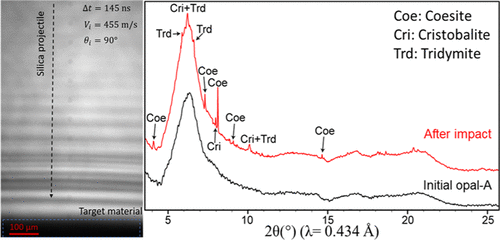当前位置:
X-MOL 学术
›
ACS Earth Space Chem.
›
论文详情
Our official English website, www.x-mol.net, welcomes your
feedback! (Note: you will need to create a separate account there.)
Coesite Formation at Low Pressure during Supersonic Microprojectile Impact of Opal
ACS Earth and Space Chemistry ( IF 2.9 ) Pub Date : 2020-07-01 , DOI: 10.1021/acsearthspacechem.0c00090 Seungyeol Lee 1, 2, 3 , Jizhe Cai 4 , Shiyun Jin 1 , Dongzhou Zhang 5, 6 , Ramathasan Thevamaran 4 , Huifang Xu 1
ACS Earth and Space Chemistry ( IF 2.9 ) Pub Date : 2020-07-01 , DOI: 10.1021/acsearthspacechem.0c00090 Seungyeol Lee 1, 2, 3 , Jizhe Cai 4 , Shiyun Jin 1 , Dongzhou Zhang 5, 6 , Ramathasan Thevamaran 4 , Huifang Xu 1
Affiliation

|
The shock metamorphism of opal-A induced by supersonic microprojectile impacts in an advanced laser-induced projectile impact test (LIPIT) was investigated using synchrotron X-ray diffraction (XRD) and transmission electron microscopy (TEM). The three-dimensional topography of the impact area is similar to the meteorite crater that has a circular outline with an uplifted rim. The post-impact synchrotron XRD and TEM analyses show the phase transformation of opal-A to coesite together with opal-CT, tridymite, and cristobalite. The impact simulation estimates that the shocked areas experienced pressures up to ∼0.6–0.7 GPa. The results suggest that the transition pressure from opal-A to coesite is lower than the transition pressure of quartz to coesite (∼2 GPa). The impact-induced phase transformation of opal-A to coesite at low pressure could be related to the local precursor structure (coesite domain) and water content (∼6.7 wt %) in opal-A. The investigation of minerals via the LIPIT technique provides a new way of simple and cost-effective shock-metamorphic experiments. The combined micron-scale ballistic test, impact simulation, and high-resolution characterization techniques will be useful to study the shock metamorphism of various minerals from macro-, micro-, to nanoscale, which will help understand the impact phenomena on Earth, Mars, and many other types of meteorites and asteroids.
中文翻译:

蛋白石的超声微弹撞击过程中低压中的堇青石形成
使用同步加速器X射线衍射(XRD)和透射电子显微镜(TEM),研究了超声速微弹撞击在超激光诱导的弹丸撞击试验(LIPIT)中引起的蛋白石A的冲击变质。撞击区域的三维地形类似于陨石陨石坑,陨石坑具有圆形轮廓和凸起的边缘。撞击后同步加速器的XRD和TEM分析表明,蛋白石A与蛋白石CT,鳞石英和方石英一起相转变为堇青石。冲击模拟估计,冲击区域承受的压力高达〜0.6–0.7 GPa。结果表明,从蛋白石A到堇青石的转变压力低于石英到堇青石的转变压力(〜2 GPa)。撞击引起的蛋白石A在低压下转变成堇青石的相变可能与蛋白石A中的局部前驱体结构(堇青石域)和水含量(约6.7 wt%)有关。通过LIPIT技术对矿物进行研究提供了一种简单且经济高效的冲击变质实验的新方法。结合的微米级弹道测试,撞击模拟和高分辨率表征技术将有助于研究从宏观,微观到纳米尺度的各种矿物的冲击变质,这将有助于理解对地球,火星,以及许多其他类型的陨石和小行星。通过LIPIT技术对矿物进行研究提供了一种简单且经济高效的冲击变质实验的新方法。结合的微米级弹道测试,撞击模拟和高分辨率表征技术将有助于研究从宏观,微观到纳米尺度的各种矿物的冲击变质,这将有助于理解对地球,火星,以及许多其他类型的陨石和小行星。通过LIPIT技术对矿物进行研究提供了一种简单且经济高效的冲击变质实验的新方法。结合的微米级弹道测试,撞击模拟和高分辨率表征技术将有助于研究从宏观,微观到纳米尺度的各种矿物的冲击变质,这将有助于理解对地球,火星,以及许多其他类型的陨石和小行星。
更新日期:2020-08-20
中文翻译:

蛋白石的超声微弹撞击过程中低压中的堇青石形成
使用同步加速器X射线衍射(XRD)和透射电子显微镜(TEM),研究了超声速微弹撞击在超激光诱导的弹丸撞击试验(LIPIT)中引起的蛋白石A的冲击变质。撞击区域的三维地形类似于陨石陨石坑,陨石坑具有圆形轮廓和凸起的边缘。撞击后同步加速器的XRD和TEM分析表明,蛋白石A与蛋白石CT,鳞石英和方石英一起相转变为堇青石。冲击模拟估计,冲击区域承受的压力高达〜0.6–0.7 GPa。结果表明,从蛋白石A到堇青石的转变压力低于石英到堇青石的转变压力(〜2 GPa)。撞击引起的蛋白石A在低压下转变成堇青石的相变可能与蛋白石A中的局部前驱体结构(堇青石域)和水含量(约6.7 wt%)有关。通过LIPIT技术对矿物进行研究提供了一种简单且经济高效的冲击变质实验的新方法。结合的微米级弹道测试,撞击模拟和高分辨率表征技术将有助于研究从宏观,微观到纳米尺度的各种矿物的冲击变质,这将有助于理解对地球,火星,以及许多其他类型的陨石和小行星。通过LIPIT技术对矿物进行研究提供了一种简单且经济高效的冲击变质实验的新方法。结合的微米级弹道测试,撞击模拟和高分辨率表征技术将有助于研究从宏观,微观到纳米尺度的各种矿物的冲击变质,这将有助于理解对地球,火星,以及许多其他类型的陨石和小行星。通过LIPIT技术对矿物进行研究提供了一种简单且经济高效的冲击变质实验的新方法。结合的微米级弹道测试,撞击模拟和高分辨率表征技术将有助于研究从宏观,微观到纳米尺度的各种矿物的冲击变质,这将有助于理解对地球,火星,以及许多其他类型的陨石和小行星。











































 京公网安备 11010802027423号
京公网安备 11010802027423号